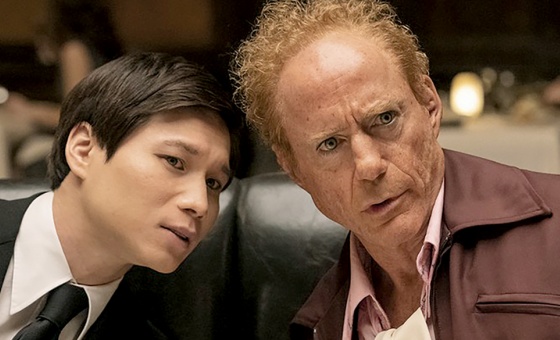This is the last article you can read this month
You can read more article this month
You can read more articles this month
Sorry your limit is up for this month
Reset on:
Please help support the Morning Star by subscribing here
The very first feature film, Tillie’s Punctured Romance, was released a hundred years ago this weekend on December 21 1914. Charlie Chaplin played the City slicker, very different from the parts he had played in his earlier comedy shorts.
Charles and Hannah Chaplin were well known entertainers on the London music hall circuit in the late 1890s. The couple would include their very young son, another Charlie, born in London on April 16 1889, in their stage act.
When the older Charlie deserted the family and died of alcoholism, mother Hannah found it increasingly hard to find work. In 1895 the family were sent to the Lambeth Workhouse.
Later Chaplin would remember: “Although we were aware of the shame of going to the workhouse, when Mother told us about it both brother Sydney and I thought it adventurous and a change from living in one stuffy room.
“But on that doleful day I didn’t realise what was happening until we actually entered the workhouse gate. Then the forlorn bewilderment of it struck me, for there we were made to separate, Mother going in one direction to the women’s ward and we in another to the children’s.”
Life in the workhouse drove Hannah mad. She was sent to the Cane Hill Lunatic Asylum in Surrey.
In another poignant memory Chaplin recalled: “I loved my mother almost more when she went out of her mind. She had been so poor and so hungry — I believe it was starving herself for us that affected her brain. She so wanted me to be a successful actor.”
Fulfilling that ambition didn’t take Charlie long. Aged 16 he played Billy in a West End production of Sherlock Holmes.
Next was Fred Karno’s famous music hall troupe. With Karno he toured the US and was spotted by Mack Sennett. The famous producer cast the young English actor in a series of short silent comedy films.
Charlie started to develop the slapstick character that would become his trademark. Baggy pants, tight coat, ill-fitting shoes and battered bowler hat.
The film Caught In The Rain marked his directing debut in 1914. His films became more serious and Chaplin used his childhood experiences of poverty to give his films both pathos and a message.
These films, revolutionary for their time, certainly caught the public imagination, filled the early cinemas and Charlie became both rich and famous.
Films like The Pawnshop, Easy Street, A Dog’s Life and particularly The Tramp And The Immigrant made his reputation and changed cinema forever.
In December 1914 he starred in the first ever full-length feature film Tillie’s Punctured Romance. Chaplin neither produced nor directed this film but full-length features would soon become part of his life and legend.
By 1918 he was the industry’s biggest star and signed cinema’s first million-dollar contract.
A year later Chaplin, Mary Pickford, DW Griffith and Douglas Fairbanks founded United Artists, thus taking film making and distribution into their own hands.
United Artists made one of Chaplin’s most famous films, The Kid, in 1921.
The important social messages in his films brought some political criticism. Chaplin was accused of being a Bolshevik and a communist.
However, a British reporter Clare Sheridan, who would later become his lover, noted: “You can see the sadness of the eyes — which the humour of his smile cannot dispel — this man has suffered.
“He is not Bolshevik nor communist nor revolutionary, as I heard rumoured. He is an individualist with the artist’s intolerance of stupidity, insincerity and narrow prejudice.”
More successful films followed including The Gold Rush, The Circus and City Lights. Chaplin’s films and the man himself became more political.
Chaplin supported Franklin D Roosevelt and his New Deal — a radical response to the Great Depression — that focused on relief and creating jobs for the unemployed and poor, rebuilding the economy and reforming the financial system to prevent another slump.
His 1936 film, Modern Times, is clearly an attack on the worst excesses of US capitalism, unemployment and austerity. His Little Tramp character struggles to survive in the modern, industrial world. At one point in the film he is caught up in a communist street demonstration.
The film horrified the US Establishment, not least J Edgar Hoover and his red-baiting FBI. He started a file on Chaplin, which would eventually grow to nearly 2,000 pages.
Among those files would be notes exchanged by British Intelligence agencies and senior US embassy staff accusing Chaplin of being secretly Jewish, an active member of the Communist Party and a keen wartime supporter of the Soviet Union.
Meanwhile across the Atlantic Hitler had come to power. Chaplin wasn’t slow to see the danger of fascism. His response in 1937 was a lampoon of Hitler — The Great Dictator.
There was huge opposition to making the film from nazi supporters in the US, from appeasers on both sides of the Atlantic and even from United Artists.
The studio had been told by the Hays Office — the official government censor — that the film would be banned. Many doubted that film could be sold in Britain.
Chaplin ignored this criticism and went ahead with the film determined that Hitler must be laughed at. He was proved right, of course, and when war came the film proved a hugely popular propaganda success.
In the last few minutes of the film we see Chaplin as the reformed dictator making a speech direct to camera. It is Chaplin’s manifesto against racism and for democracy, against war, capitalism and for a better society. It is easily available on YouTube. Watch it and you will understand why Chaplin was so hounded for his political views.
As war raged Chaplin was a key player in the American Committee for Russian War Relief. He spoke out supporting the 1942 campaign to open a second front in Europe.
When peace came the red-baiting started again with a vengeance. The House of Un-American Activities Committee (HUAC) began to investigate communist influence in Hollywood. Charlie Chaplin was an early target.
In 1952 Chaplin came to London for the premiere of his film Limelight. When he tried to return to the US he was shocked and disgusted to discover his entry permit had been revoked. Behind his back the FBI and HUAC had taken away his right to live and make films in the US.
Chaplin was just one of hundreds of banned filmmakers. But his reaction to the blacklisting was typical of the man.
In 1957 he made a film in Britain, the hilarious romp A King In New York — it stars Chaplin as the deposed king of Estrovia who flees to US where he is tormented by McCarthy-style investigations.
The film enraged Hoover and bought yet more accusations that Chaplin was a communist. The film was banned in the US. It would not be shown there for 15 years.
In exile, Chaplin wrote his autobiography and made one more film, his only one in colour — A Countess from Hong Kong — it featured Charlie only in a cameo part but he wrote, produced and directed it. Marlon Brando, Sophia Loren, Tippi Hedren and Sydney Earle Chaplin, Chaplin’s second son featured. He also wrote the music and one song This Is My Song became a chart topping No1 hit for Petula Clark.
By 1972, US public opinion had changed. Hoover, McCarthy and other red-baiters were discredited and Chaplin was invited back to receive a special Oscar and a 12-minute ovation — the longest ever in Academy history.
Finally his wonderful satire on McCarthyism, A King in New York was released to great acclaim from the US movie-going public.
Charlie Chaplin died aged 88 in Switzerland on Christmas Day 1977. His films however, and the radical political messages they contain, will live on forever — an important part of the magic of the movies.









